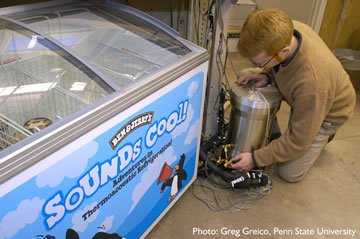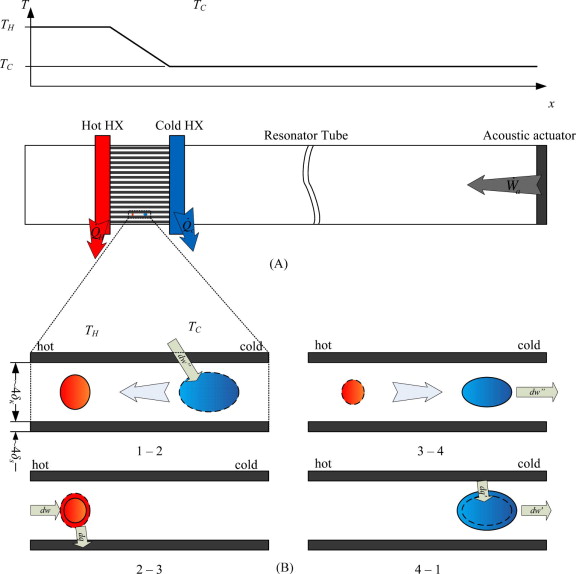'Sound' is a Source of Cooling!
Scientifically speaking, refrigeration is a process of cooling a specific area to reach a certain temperature lower than ambient temperature. However, in this article, I will introduce you to a new type of cooling and refrigeration which I research for my Ph.D. thesis.

Figure 1: Model of a Thermoacoustic Refrigerator. Source: http://www.acs.psu.edu/thermoacoustics/refrigeration/benandjerrys.htm
'Thermoacoustic Refrigeration' or simply saying TAR, is a cooling device which uses sound waves in order to produce cooling. It is of a great benefit to the environment since it does not require any refrigerant for functioning, unlike vapor compression systems.

Figure 2: Ben & Jerry's Refrigerator. Source: http://www.acs.psu.edu/thermoacoustics/refrigeration/benandjerrys.htm
TAR consists of the following parts:
1. Stack: This is the most significant part and the heart of the system where cooling takes place. It consists of a number of parallel plates. The ends of these plates are attached to heat exchangers (1 cold and 1 hot). Usually, a stack is made of low thermal conductivity materials in order to avoid losses in cooling power.
2. Heat Exchangers: At the ends of the stack, as I listed above, we attach a cold heat exchanger (CHX) to one end and a hot heat exchanger (HHX) to the other end. Heat exchangers are necessary to supply and extract heat at the ends of the stack.
3. Resonator: A tube filled of gas (Helium or Air) which contains the stack and the heat exchangers.
4. Loudspeaker: The source of sound waves in the resonance tube.
5. Working Fluid: Usually we use Helium gas as a working fluid because it has the highest thermal conductivity and speed of sound among inert gases.
How a TAR works?
Sound waves emitted from the loudspeaker propagate in the resonance tube causing the working gas to compress and expand and therefore causing the gas to heat and cool. Heat is then extracted from the cold side of the stack and absorbed by the hot side. The only challenge to overcome is achieving high efficiency same as vapor compression refrigerators.

Figure 3: Compression and Rarefaction of gas particles taking place inside the stack. Source: https://www.researchgate.net/figure/A-Schematic-of-a-thermoacoustic-refrigerator-B-Working-principle-of-a-thermoacoustic_fig11_255812361
Written by:
Ahmad Kouta
Ph.D. at Technical University of Liberec, Czech Republic,
Department of Mechanical Engineering,
Research in Thermoacoustic Technology with focus on Cooling Electronics
This is great. I have no phd, but i had a vision once, soundwaves and frequencies are the way to heal & save humanity. And i truely believe, findings like yours are helping humanity to become on the right path. So thank you.
Thank you for your motivation. I really appreciate it. I also hope we can achieve high efficiencies in our experiments so that one day this clean technology becomes commercial.
This is really interesting just out of curiosity how loud is the sound. Also I am sure it exists but what is the ideal frequency? Like a glass breaking "ehhhhh" or and earth shaking "BOOM"! If you don't mind, I looked around and couldn't find anything specific to ideal amplitudes and frequencies.